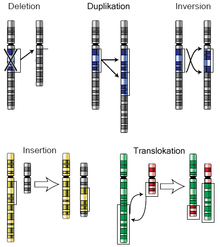Chromosome mutation
A chromosome mutation (also: structural chromosome aberration ) is a structural change in a chromosome that is visible in cytogenetic chromosome preparations with a light microscope . In other words, they are major modifications that change the sequence of genes and other elements on the chromosome. Such changes in a cell are passed on to the daughter cells. Arise from these cells daughter organisms (animals ie in cells of the germ line ), the mutation to offspring inherited .
Chromosome mutations are combined with genome mutations , in which the number of chromosomes changes, to form chromosome aberrations . In contrast, mutations that only affect a single gene and are therefore not visible with a light microscope are referred to as gene mutations .
Classification of chromosome mutations
There are five types of chromosome mutations:
- Deletion : A part of the chromosome (tail or middle section) is lost.
- Translocation : Chromosomes can break apart and in the process lose parts that are attached to the chromatid of another chromosome.
- Duplication : A section of the chromosome is duplicated because a broken part has been incorporated into the sister chromatid.
- Inversion : Within a chromosome, after a double break, a piece can be reversed again.
- Insertion (also: addition): Here a chromosome has an additional part.
Effects
Some of these changes lead to serious illness , disability, and malformations . The reason for this is mostly a gene dose effect: Usually a gene is present in a certain number (in humans twice = disome), with the exception of the genes of the sex chromosomes . In the case of deletions and duplications , however, this is no longer the case; genes then appear more or less frequently. Even small changes of this kind can lead to cell death .
Translocations and inversions often have no effect at first, since the number of genes does not change (= balanced translocation / balanced inversion), only their position. Difficulties in meiosis , however, can lead to further chromosomal aberrations in the offspring.
In some translocations, the reassembly of chromosome segments results in gene segments recombining so that oncogenes arise, for example in the Philadelphia chromosome . Sometimes there can also be position effects.
Examples
Chromosome mutations include, for example, the loss of certain chromosomal segments. In this category fall the Williams Syndrome (deletion of 1.5 million base pairs on 7q11.23), the Wolf-Hirschhorn syndrome (partial deletion of the short arm of chromosome 4), the microdeletion 22q11 and the Cri-du chat syndrome (from the French, German Katzenschrei-Syndrom). The latter was discovered as the first partial deletion in humans in 1963. It is caused by a deletion on chromosome 5. Newborns and infants with this syndrome will notice high-pitched, whimpering screams.
Individual evidence
- ↑ William Hovanitz: Textbook of Genetics. Elsevier Press, Houston / New York 1953, p. 190: “ (…) if a change in structure (of chromosomes) is large enough to be visible in cytological preparations it is considered a chromosomal mutation. If it is too small to be readily observed, is known only from the genetic results of segregation and can be localized on a chromosome, it is known as a gene mutation. There is no sharp dividing line between gene mutations and chromosomal mutations. Eventually all gene mutations in their ultra-fine structure will be found to be structural, if only in the molecular arrangement of which the gene is composed. ”
- ↑ a b Werner Buselmaier, Gholamali Tariverdian: Humangenetik. Text accompanying the item catalog . Springer, Berlin / Heidelberg / New York 1991, ISBN 3-540-54095-4 .
- ↑ Eberhard Passarge: Pocket Atlas of Human Genetics . Thieme Verlag, Stuttgart 2008, ISBN 978-3-13-759503-8 .

